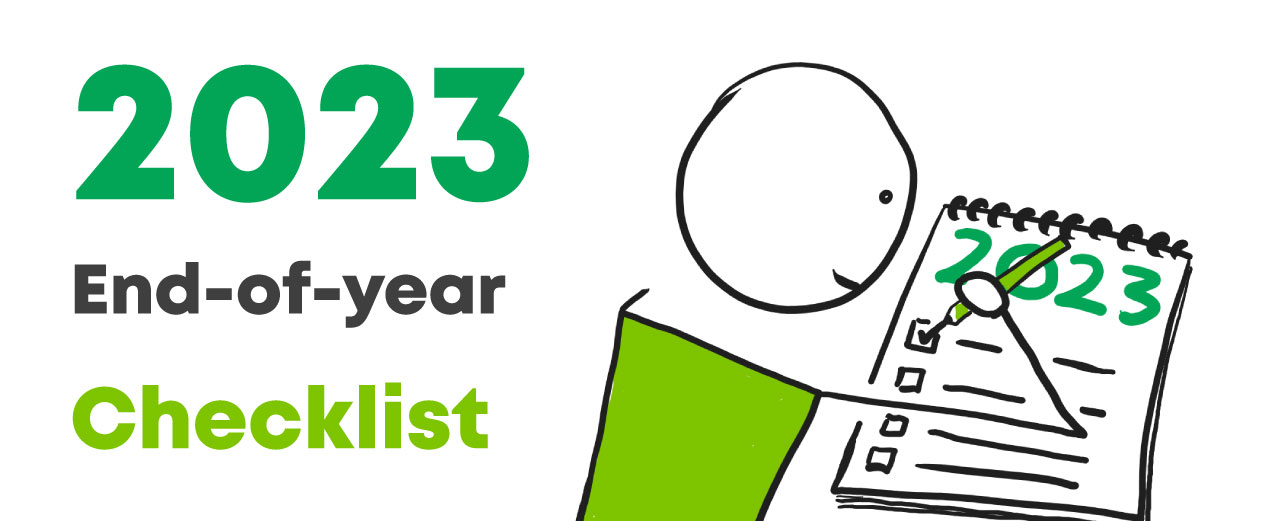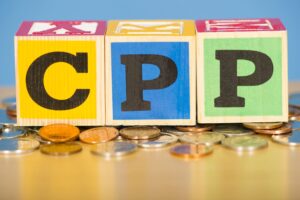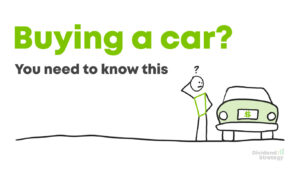When I help people one-on-one with their financial planning needs, there is one financial goal that comes up more than all the rest: “I don’t want to have to worry about money.”
Most of us, even if we have an interest in personal finance and investing, would rather spend our time doing things we enjoy rather than agonize over financial decisions. Fortunately, there’s a very reliable way to avoid the stress and improve our outcomes. All it takes is a little planning up-front along with annual maintenance and you can have a stress-free financial life. I’d like to make that process a little easier for you with this post.
The following is a checklist you can use to ensure you’re setting yourself up for success in 2024. We all have weaknesses, so don’t feel bad if some or even most of these items have been neglected for a while. Let’s find them and fix them. Depending on how well your baseline financial plan was set-up, this could take as little as an hour or as long as a few days. Either way, I guarantee it will be worth your time.
set it up right for 2024!
Simple steps to more wealth and less stress
1. Review your spending
- You might as well get the hardest job done first. Unless you’re in that 3% of the population that actually enjoys budgeting, there’s only one other way to ensure your expenses are sustainable – track them.
- At the very least, gather up all your credit card and bank account statements, look them over line by line and add up the totals. Even better, break it down by category. How much are you spending on restaurants? Travel? Interest payments?
- This is so important that I’ve done half the work for you by building a Spending Tracker Spreadsheet you can download for free!
2. Calculate your net worth
- Add up what you own (all of your accounts and a conservative estimate of your real estate value) and subtract what you owe (mortgage, car loans, etc.) – presto! That’s your net worth
- Tracking your net worth year over year is a simple but powerful assessment of your overall financial health and trajectory
3. Contribute to your RRSP
- Technically, you have until the end of February 2024 to use 2023 RRSP contribution room, but when it comes to investing, it rarely pays to wait. Furthermore, claiming the tax deduction now will lower your income tax bill, so get this squared away
- While you’re looking at your accounts, step back and look at the investment platform you’re using too. If you want to level-up your DIY investing experience, you might want to give Qtrade a try. Ranked #1 by Surviscor for best desktop experience, Qtrade also has a cashback offer of up to $2000 for readers of this blog
4. Contribute to your TFSA
- For many people, TFSAs are even more powerful than RRSPs, particularly those with lower incomes. That includes many retirees. If you’re retired and you have non-registered savings, use them to max-out your TFSA.
- If you withdrew money from your TFSA in 2023, don’t forget that you can only re-contribute that money without penalty in 2024.
5. Contribute to your RESP
- RESPs are the best deal around when it comes to saving for post-secondary education. The lifetime contribution limit per beneficiary is $50,000 and the government will chip in 20% of the first $2500 annual contribution per child – that’s a bonus $500 per year (CESG).
- If you missed a year or two, don’t worry. You can catch up on missed CESG payments one year at a time – i.e. by contributing $5000 rather than $2500
6. Open a FHSA (First Home Savings Account)
- Brand new in 2023, the FHSA is a gift to anyone who is saving for their first home. If you qualify and have the ability to contribute, you should open one.
- Why is this account so good? It’s like an RRSP + TFSA love-child: you get a tax deduction for your contribution (up to $8000 per year, $40,000 total), the money grows tax-free, AND the money can be withdrawn tax-free as well.
- The cherry on top is that if you don’t use the funds to buy a home in the next 15 years, you can simply transfer it into your RRSP
7. Tax-Loss Harvesting:
- Review your non-registered investment portfolio for tax-loss harvesting opportunities.
- Realized capital losses can be used against capital gains this year, carried back three years, or carried forward indefinitely.
- This doesn’t mean selling a quality stock that fits with your investment plan, but hanging onto losers because you’re hoping to break even at some point is not a plan, it’s wishful thinking.
8. Review Your Debt Situation:
- Assess your outstanding debts and develop a plan to pay them off. You can prioritize the highest-interest debts first (the avalanche approach) or rack up wins more quickly by going for the smallest balances first (the snowball approach). Either way, make a plan and stick to it.
- Many of my clients have opted to use funds from their non-registered accounts or TFSAs to pay down some of their debt. With interest rates of 7%+, this can make a lot of sense.
9. Charitable Contributions:
- Make any desired charitable contributions before year-end for tax deductions.
- Ensure donations are made to eligible charities.
10. Review Insurance Policies:
- Review your life, disability, and property insurance policies.
- Unless you’re financial independent already, chances are you need life and disability insurance.
- When it comes to life insurance, almost everyone should stick with a simple “Term” policy and stay away from complex, expensive “Whole” or “Universal” policies.
- Disability insurance should cover about 70% of your income
- Now is also a great time to compare Home and Auto insurance rates. We recently found an opportunity to save almost $1000 on our auto insurance.
11. Create an Emergency Fund
- An emergency fund is like your own personal insurance policy against those expensive “sh*t happens” events that no one saw coming – but you get to keep all the premiums
- Unless you need/want to have enough money to carry you through 3 – 6 months of unemployment, I think the usual advice of 3 – 6 months of living expenses is too much. One or two months’ worth is usually good and far more palatable.
- A high-interest savings account works great for this. I use EQ Bank because they seem to have the best interest rates and I like their platform.
12. Update your will
- If you have assets, you need a will. Plain and simple.
- Everyone procrastinates this job and everyone feels great relief when it’s done – so just do it.
13. Review Your Investment Portfolio:
- Tis the season for rebalancing. Start with your target asset allocation (stocks vs. fixed income); what do you need to buy/sell to get back to target? Then see how far you’ve deviated from your geographic targets and do the same thing. Finally, if you own individual stocks, have a look at your sector allocations and calculate the funds you will need to move to get those back in line with your investment plan. Taking a top-down approach like this is the only way to make this job manageable.
- Before you even get to making the trades, however, make sure your investment plan still aligns with your risk tolerance and financial goals.
- If you’re using the Retirement Bucket approach, now is also a great time to add a rung to your GIC ladder
14. Get ready to front-load your accounts in 2024
- If you’re a real financial superstar, you’ll start planning your 2024 investing now. Next year’s TFSA, RRSP, RESP, and FHSA contribution room is available January 1st. Getting as much money into those accounts as early as possible means more time for tax-free compounding to work its magic.
- Don’t wait. Chances are prices will be higher later in the year, so get your money invested. Do this every year for many years and the results will be dramatic.
Being a DIY investor means taking on a lot more than just investing. We should really call it “DIY financial planning”. I hope this checklist helps you perform that role more effectively. Do you have a different end-of-year routine? Anything I missed? Feel free to comment.
Happy Holidays!
Thank you so much to those of you who have chosen to support me and this blog with your donations. Your generosity has a huge impact on the quality of this site. You can support this site by clicking below or by sending an e-transfer to contact@dividendstrategy.ca. Half of all donations are donated to Doctors Without Borders.





Transfers of securities in kind to a TFSA does trigger tax consequences.
Absolutely right. Not sure what I was thinking. Thanks, Jan!
On the FHSA #6 one of the important points that you should start an account and sign up in 2023 to get the $8000 credit! You don’t have put money in and would have addition year of credits when you deposit! The point is if you start an account in 2024 you can deposit $16000 instead of $8000! Correct me if I’m wrong! Enjoy your day!
I agree, William. Also recognizing that the maximum carryforward is $8000 and it can only be carried-forward one year.
Very, very helpful advice and Roadmap. Thank you.
By the way, approximately when should we expect your regular yearly update on BTSX ?
“RRSP room is carried forward from past years, but the tax deduction isn’t”
Can you please elaborate a little on this?
I thought if contributed and deduction not claimed, it’s available to be claimed in future.
Thank you.
Hi Bhai – Sorry, I’m going to edit that part for better clarity. What I meant is that you would miss out on the tax deduction for this year. This is important for two reasons: first, the time value of that money; second, having the deduction applied to the highest marginal tax rate for your earnings (as opposed to a larger deduction down the road that would push you into lower and lower tax brackets, thereby being less and less beneficial). Does that make sense? You are absolutely right about the ability to defer the tax deduction.
Perhaps I should not try to write blog posts while fighting COVID, but I really wanted to get this one out before Christmas! Thanks for the comment!
This is really good information for DIY’ers. All the regular stuff that everyone should address. About investing, I talked to friends last week about getting rid of their mutual funds and advisors so they could make more money. But they said that is not for them, too complicated. Everyone is entitled to make their own decisions, but I can’t help commenting. Investing can be simplified. The BTSX method is something anyone can easily follow. But as soon as you say re-balancing, they think here we go, too complicated. For me, it’s even simpler. We hold the same dividend paying stocks and let them grow. I have never re-balanced. Occasionally sold a holding or added a new one. But in the last years the portfolio has not change. Just used some stock shares for charitable giving and that is it. Dividends and retirement go well together. But that’s just me.
Great articles as always! Just one comment/question about Point #14: I found out about a restriction that contributions to the FHSA within the first 60 days of a year are not tax deductible from the previous year’s income (https://www.canada.ca/en/revenue-agency/services/tax/individuals/topics/first-home-savings-account/contributing-your-fhsa.html#h_6). Does that mean you lose the tax deduction capabilities, or that you can only apply the tax deduction to the contribution year’s tax return (e.g. when contributing on Jan 1st, 2024, I would only be able to claim it on 2024’s tax return and not 2023)?
You can only apply the tax deduction for the year in which you make the contribution – hence, an important end-of-year checklist item!